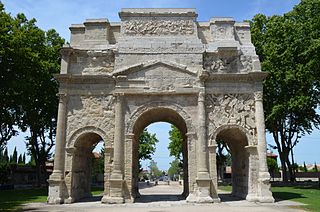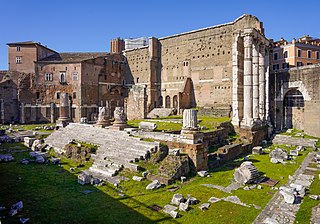This is a list of Roman triumphal arches. Triumphal arches were constructed across the Roman Empire and are an archetypal example of Roman architecture. Most surviving Roman arches date from the Imperial period (1st century BC onwards). They were preceded by honorific arches set up under the Roman Republic.
Note: MUR stands for the 12th century Mirabilia Urbis Romae
| Image | Name | Date of construction | Date destroyed | Modern city | Modern country | Notes | Citation |
|---|---|---|---|---|---|---|---|
| Arch of Arcadius, Honorius and Theodosius | 405 AD | 1362–1370 | Rome | Italy | MUR, p. 10. | ||
 | Arch of Augustus | 29 BC | Rome | Italy | Some fragments survive | ||
 | Arch of Claudius | 51–52 AD | Rome | Italy | Some fragments survive | MUR, p. 12. | |
| Arch of Faustinus | After 12th century | Rome | Italy | MUR, p. 13. | |||
| Arch of Gratian, Valentinian and Theodosius | 379–383 AD | c. 13th century | Rome | Italy | MUR, p. 10. | ||
| Arch of Lentulus and Crispinus | 2nd century AD | 15th century | Rome | Italy | |||
| Arch Manus Carnae (Hand of Flesh) | After 12th century | Rome | Italy | MUR, p. 13. | |||
| | Arch of Nero | 58–62 AD | c. 1st century AD | Rome | Italy | ||
| Arcus Novus | 293–304 AD | 1491 | Rome | Italy | Some reliefs survive | ||
| Arch of Octavian or Marcus Aurelius | After 12th century | Rome | Italy | MUR, p. 12. | |||
| Arch of Octavius | c. 28 BC | Rome | Italy | ||||
| Arch Panis Aurei or Aureus (Golden) | After 12th century | Rome | Italy | MUR, p. 13. | |||
| Arch of Pietas | After 12th century | Rome | Italy | MUR, p. 13. | |||
 | Arch of Portugal | c. 3rd century AD | 1662 | Rome | Italy | Some reliefs preserved at the Capitoline Museums | MUR, p. 10. |
| Arch of Tiberius | 16 AD | Rome | Italy | Some foundations still survive | |||
| Arch of Titus | 81 AD | After 15th century | Rome | Italy | Some fragments still survive | MUR, p. 11. | |
 | Monumental Arch | 3rd century AD | October 2015 | Palmyra | Syria | Most of the stonework is still intact | |
 | Arch of Theodosius | 393 AD | 6th–8th centuries | Istanbul | Turkey | Some fragments still survive | |
| Arch at Richborough Castle | c. 1st century AD | Richborough | United Kingdom | Foundations and mound still visible | |||

Ancient Roman architecture adopted the external language of classical ancient Greek architecture for the purposes of the ancient Romans, but was different from Greek buildings, becoming a new architectural style. The two styles are often considered one body of classical architecture. Roman architecture flourished in the Roman Republic and to an even greater extent under the Empire, when the great majority of surviving buildings were constructed. It used new materials, particularly Roman concrete, and newer technologies such as the arch and the dome to make buildings that were typically strong and well engineered. Large numbers remain in some form across the former empire, sometimes complete and still in use today.

The Arch of Titus is a 1st-century AD honorific arch, located on the Via Sacra, Rome, just to the south-east of the Roman Forum. It was constructed in c. 81 AD by Emperor Domitian shortly after the death of his older brother Titus to commemorate Titus's official deification or consecratio and the victory of Titus together with their father, Vespasian, over the Jewish rebellion in Judaea.

A triumphal arch is a free-standing monumental structure in the shape of an archway with one or more arched passageways, often designed to span a road, and usually standing alone, unconnected to other buildings. In its simplest form, a triumphal arch consists of two massive piers connected by an arch, typically crowned with a flat entablature or attic on which a statue might be mounted or which bears commemorative inscriptions. The main structure is often decorated with carvings, sculpted reliefs, and dedications. More elaborate triumphal arches may have multiple archways, or in a tetrapylon, passages leading in four directions.

The Arch of Constantine is a triumphal arch in Rome dedicated to the emperor Constantine the Great. The arch was commissioned by the Roman Senate to commemorate Constantine's victory over Maxentius at the Battle of the Milvian Bridge in AD 312. Situated between the Colosseum and the Palatine Hill, the arch spans the Via Triumphalis, the route taken by victorious military leaders when they entered the city in a triumphal procession. Dedicated in 315, it is the largest Roman triumphal arch, with overall dimensions of 21 m (69 ft) high, 25.9 m (85 ft) wide and 7.4 m (24 ft) deep. It has three bays, the central one being 11.5 m (38 ft) high and 6.5 m (21 ft) wide and the laterals 7.4 m (24 ft) by 3.4 m (11 ft) each. The arch is constructed of brick-faced concrete covered in marble.

The Circus Flaminius was a large, circular area in ancient Rome, located in the southern end of the Campus Martius near the Tiber River. It contained a small race-track used for obscure games, and various other buildings and monuments. It was "built", or sectioned off, by Gaius Flaminius in 221 BC. After Augustus divided the city into 14 administrative regions, the Circus Flaminius gave its name to Regio IX, which encompassed the Circus and all of the Campus Martius west of the Via Lata.

Mirabilia Urbis Romae is a grouping of hundreds of manuscripts, incunabula, and books in Latin and modern European languages that describe notable built works and historic monuments in the city of Rome. Most of these texts were intended as guidebooks to the city for pilgrims and visitors. Before the fourteenth century, however, the core text seems instead to have served as a census of the built patrimony of the city, the decus Urbis. This inheritance represented the strength of Rome and the power of the institutions that controlled it.

The Circus of Maxentius is an ancient structure in Rome, Italy, part of a complex of buildings erected by emperor Maxentius on the Via Appia between AD 306 and 312. It is situated between the second and third miles of the Via Appia, between the basilica and catacombs of San Sebastiano and the imposing late republican tomb of Caecilia Metella, which dominates the hill that rises immediately to the east of the complex. It is part of the Appian Way Regional Park.

The Temple of Mars Ultor was a sanctuary erected in Ancient Rome by the Roman Emperor Augustus in 2 BCE and dedicated to the god Mars in his guise as avenger. The centerpiece of the Forum of Augustus, it was a peripteral style temple, on the front and sides, but not the rear, raised on a platform and lined with eight columns in the Corinthian order style.

The Umbilicus Urbis Romae —"Navel of the City of Rome"—was the symbolic centre of the city, a reference point from which, and to which, all distances in Ancient Rome were measured. It was situated in the Roman Forum where its remnants can still be seen. These remains are located beside the Arch of Septimius Severus and the Vulcanal, behind the Rostra. Originally covered in marble, the Umbilicus is now a forlorn-looking brick core some 2 metres high and 4.45 metres in diameter.

The Temple of Antoninus and Faustina is an ancient Roman temple in Rome, which was later converted into a Roman Catholic church, the Chiesa di San Lorenzo in Miranda or simply "San Lorenzo in Miranda". It is located in the Forum Romanum, on the Via Sacra, opposite the Regia.

The Arch of Augustus was the triumphal arch of Augustus, located in the Roman Forum. It spanned the Via Sacra, between the Temple of Castor and Pollux and the Temple of Caesar, near the Temple of Vesta, closing off the eastern end of the Forum. It can be regarded as the first permanent three-bayed arch ever built in Rome.

The lesser-known Arch of Titus was a triple bay arch erected at the eastern end of the Circus Maximus by the Senate in A.D. 81, in honour of Titus and his capture of Jerusalem in the First Jewish–Roman War. Few traces remain. The inscription, quoted by an 8th-century Swiss monk known only as the "Einsiedeln Anonymous", makes it clear that this was Titus' triumphal arch. Sculptural fragments of a military frieze have been attributed to the arch.

Forum of Nerva is an ancient structure in Rome, Italy, chronologically the next to the last of the Imperial fora built.
De mirabilibus urbis Romae, preserved in a single manuscript in Cambridge, England, is a medieval guide in Latin to the splendours of Rome, which was written in the mid-twelfth century by a certain Magister Gregorius of Oxford. The outlook here is even more secular than the Mirabilia urbis Romae, Roberto Weiss noted. Gregorius spent much of his time describing and even measuring the Roman ruins, and, according to Erwin Panofsky "had yielded so thoroughly to the 'magic spell' of a beautiful Venus statue that he felt compelled to visit it time and again in spite of its considerable distance from his lodgings". Magister Gregorius is the first to take notice of the Roman bronze called the "Spinario", then among ancient bronzes at the Lateran. Panofsky included Magister Gregorius's little book among examples of the reawakening of interest in classical antiquities evinced by a handful of connoisseurs in twelfth-century Rome. Still, like most of his contemporaries raised in familiarity with the Gothic hand, the unfamiliar Roman letters in inscriptions sometimes eluded his translation.

The Pons Neronianus or Bridge of Nero was an ancient bridge in Rome built during the reign of the emperors Caligula or Nero to connect the western part of the Campus Martius with the Ager Vaticanus, where the imperial family owned land along the Via Cornelia.

The topography of ancient Rome is the description of the built environment of the city of ancient Rome. It is a multidisciplinary field of study that draws on archaeology, epigraphy, cartography and philology. The word 'topography' here has its older sense of a description of a place, now often considered to be local history, rather than its usual modern meaning, the study of landforms.

The Temple of Isis and Serapis was a double temple in Rome dedicated to the Egyptian deities Isis and Serapis on the Campus Martius, directly to the east of the Saepta Julia. The temple to Isis, the Iseum Campense, stood across a plaza from the Serapeum dedicated to Serapis. The remains of the Temple of Serapis now lie under the church of Santo Stefano del Cacco, and the Temple of Isis lay north of it, just east of Santa Maria sopra Minerva. Both temples were made up of a combination of Egyptian and Hellenistic architectural styles. Much of the artwork decorating the temples used motifs evoking Egypt, and they contained several genuinely Egyptian objects, such as couples of obelisks in red or pink granite from Syene.
The Arch of Gratian, Valentinian and Theodosius was a triumphal arch built between 379 and 383 AD in Rome. It was situated at the south end of the Pons Aelius, near to the site later occupied by the church of San Celso. It formed as a monumental entrance arch to the bridge.
The Arch of Scipio was an ancient Roman arch located atop the Capitoline Hill.